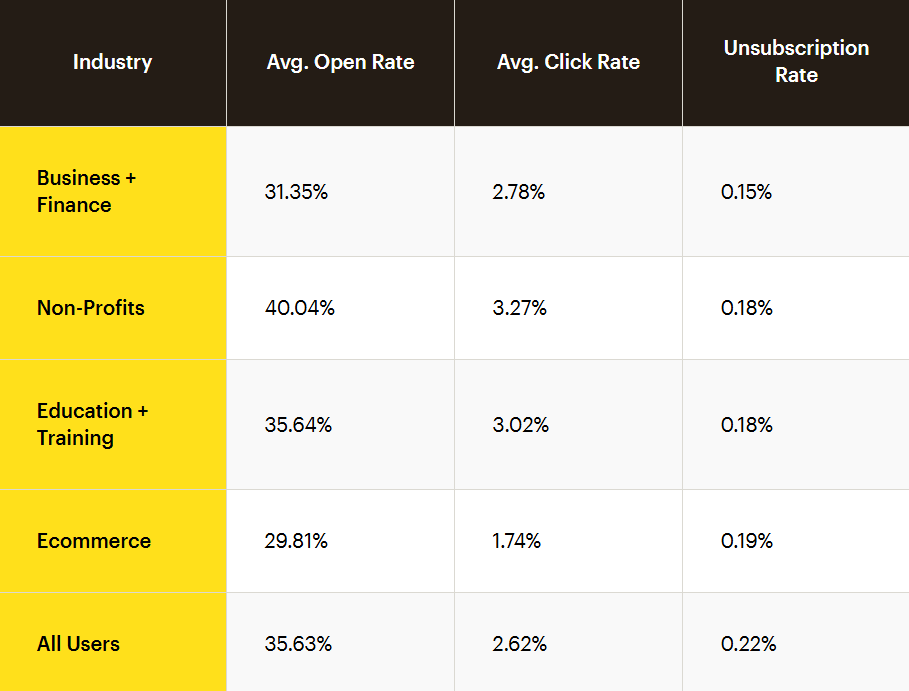These benchmarks serve as vital metrics that enable businesses to gauge the effectiveness of their email marketing strategy.
By comparing key performance indicators (KPIs) such as open rates, click-through rates, and conversion rates against industry averages, businesses can identify areas of strength and weakness in their campaigns while measuring their performance against competitors and industry leaders.
In assessing and optimizing marketing performance, email marketing benchmarks can act as a compass for businesses, guiding them toward data-driven decision-making. By tracking metrics and marketing benchmarks, companies can fine-tune their email marketing strategies to help enhance engagement and retention.
Email marketing benchmarks can provide a baseline against which businesses can set targets for improvements and measure the success of their optimization efforts. Additionally, they offer a framework for testing and experimenting with different elements of email campaigns, such as subject lines, visuals, and call-to-action buttons.
Meanwhile, finding an industry average for each important business metric can further enhance this process by offering context and insights tailored to the unique dynamics and expectations of particular sectors, empowering businesses to make informed, strategic designs that align with their goals.
Keep reading to find our email marketing campaign stats by industry to help benchmark your email marketing performance.
Average email marketing campaign statistics by industry
There are a lot of numbers in Mailchimp’s reports on email and marketing automation, but you might be wondering how your stats compare to others in the same industry. What kind of open rates should companies like yours expect? How many bounces are too many? What’s the average click-through rate for businesses like yours? What data do content marketers rely upon to improve engagement rates? The more context, the better.
Mailchimp sends billions of emails a month for millions of users. Needless to say, we track a lot of data. So we scanned billions of emails delivered by our system (where campaign tracking was activated, and where users reported their industry) and calculated the average unique open rates, click rates, soft bounce rate, and hard bounce rate by industry.
We only tracked campaigns that went to at least 1,000 subscribers. Our customers range from 1-person startups, small businesses to Fortune 500 companies, so the whole spectrum is represented in this data. Here’s your apples-to-apples comparison of email marketing metrics with others in your industry.
The data provided on this page was last updated in December 2023 and may vary from email marketing benchmarks data provided within the Mailchimp application.
*Disclaimers
The accuracy of email open rates may be impacted by Apple’s privacy changes and their Mail Privacy Protection (MPP) feature, and this should be considered as you interpret open rate data.
These figures are based on available data as of December 2023
By leveraging our extensive data analysis on email and marketing automation, businesses can gain invaluable insights into industry-specific benchmarks, offering a deeper understanding of their campaign performance. Companies can now contextualize their own metrics by examining open rates, click-through rates, and bounce rates.
Armed with the knowledge of industry performance, companies can establish realistic objectives and tailor their strategies for optimal engagement. Whether fine-turning content for better click-through rates or addressing bounce rates, these benchmarks provide a baseline for improvement.
Strategies for improving open rates
Achieving higher open rates in email marketing can be a fundamental goal for businesses aiming to enhance their reach and engagement with their audience. The open rate measures the percentage of recipients who open an email and is a KPI that can reflect the effectiveness of your email campaigns.
Let’s dive into a few of the best strategies for helping improve open rates:
1. Craft compelling subject lines to boost email open rates
Subject lines are the gateway to your email content, making them a critical component of any email marketing campaign. They’re the first impression your audience has of your email, and can influence their decision to open or ignore your message.
A well-crafted subject line can pique curiosity, convey value, and establish a connection with your subscribers.
Let’s explore some of the best practices to help guide you in crafting compelling subject lines that entice your audience and elevate your email marketing campaigns:
Personalized email subject lines
Use merge tags to personalize your subject lines with each recipient’s name or location. Personalized emails may increase open rates for most users, and may work well when combined with marketing automation in transactional emails, such as birthday deals, post-purchase follow-ups or promotional emails.
Be descriptive
Sometimes, it’s better to be direct and descriptive than trendy. Seasonal slogans such as “Fall into savings” or “Sizzling summer bargains” are popular but don’t offer a specific hook. Instead, try to communicate the benefits of your promotions, or call attention to specific deals.
Keep it short
For many recipients, especially those reading your emails on mobile devices, shorter is often better. We recommend you use no more than 9 words and 60 characters.
Limit punctuation
Our research shows that it’s best to use no more than 3 punctuation marks per subject line. Too many punctuation marks can make your email look like spam, especially if you use a lot of special characters.
Use emojis carefully
Our built-in emoji picker is a fun and easy way to add some visual pizazz to your subject lines. However, there are a few things to keep in mind when you use emojis.
According to our research, you should use no more than 1 emoji at a time. Use emojis to supplement words rather than replace them, to make sure your main message gets across.
Different operating systems render different versions of emojis, so it’s important to test.
2. Optimize audience segmentation for enhanced open rates
Audience segmentation is a cornerstone of successful email marketing. Rather than adopting a one-size-fits-all approach, segmentation involves categorizing your email subscribers based on specific criteria, such as demographics, behavior, or preferences.
By understanding the unique characteristics and needs of different segments within your audience, you can tailor your email content to be more relevant and personalized. This targeted approach can foster a stronger connection with subscribers and can significantly enhance the likelihood of capturing their attention and driving higher open rates.
Let’s take a look at a few tips for optimizing audience segmentation:
Keep your segments more widely defined
Although the point of audience segmentation is to aim for specificity, it’s possible to segment your audience too far. It’s essential to have a smaller market with a defined need. If your market is so narrowly defined that it barely contains anyone, however, that’s a problem. You’ll either reach too few people, or you’ll end up spending time and energy writing messages for too many different audiences. Focus on a few groups, but keep those groups broad enough to encompass relatively wide swaths of your customer base.
Aim for constant improvement
If the combination of audience segmentation strategies you used didn’t work, experiment with another mix until you find the most effective way to reach your potential customers. Measure the data to see where people are landing on your site, how long they’re staying, and what’s making them leave. Then incorporate that data into your next effort and into the day-to-day operations of your marketing.
Set goals, then measure them
Marketing goals are important. If your objective is to “reach more people,” for example, define what you’re looking to see from each of your segmented campaigns. That can include adding 500 more subscribers to your email newsletter, increasing the total number of products you sell by 20%, or doubling your email campaign’s click-through rate.
You should also make sure that your goals for each segment and your company’s overall goals are in sync with each other. Once you’ve set those goals, track them. If you met them, great!
If not, some tweaking is necessary. Setting goals and measuring them is simple—and it can provide valuable insights into the strengths and weaknesses of a marketing plan.
3. Use different channels
While email lists are absolutely key to communicating directly with your customers, there are more marketing channels you can explore when it comes to building better relationships and improving response rates.
Reach out to your customers with posts on social media on the platforms you know they’re most likely to use. Does your company sell ethically made makeup products? See about working with a beauty influencer on Instagram. Do you run a digital marketing agency? Try building a strong presence on Twitter and LinkedIn.
You can also reach and provide value to your audiences through blogging, whether it’s through your own site or someone else’s. Write a blog post that details something useful and position yourself as an authority on your product.
If you’ve got the skills or budget for it, try creating YouTube videos that are relevant to your target audience. Include links in the videos’ descriptions to get more subscribers to your email list or blog.
When you use different channels thoughtfully, you may see a return on that effort in the form of increased interest, increased sales, and repeat customers.




